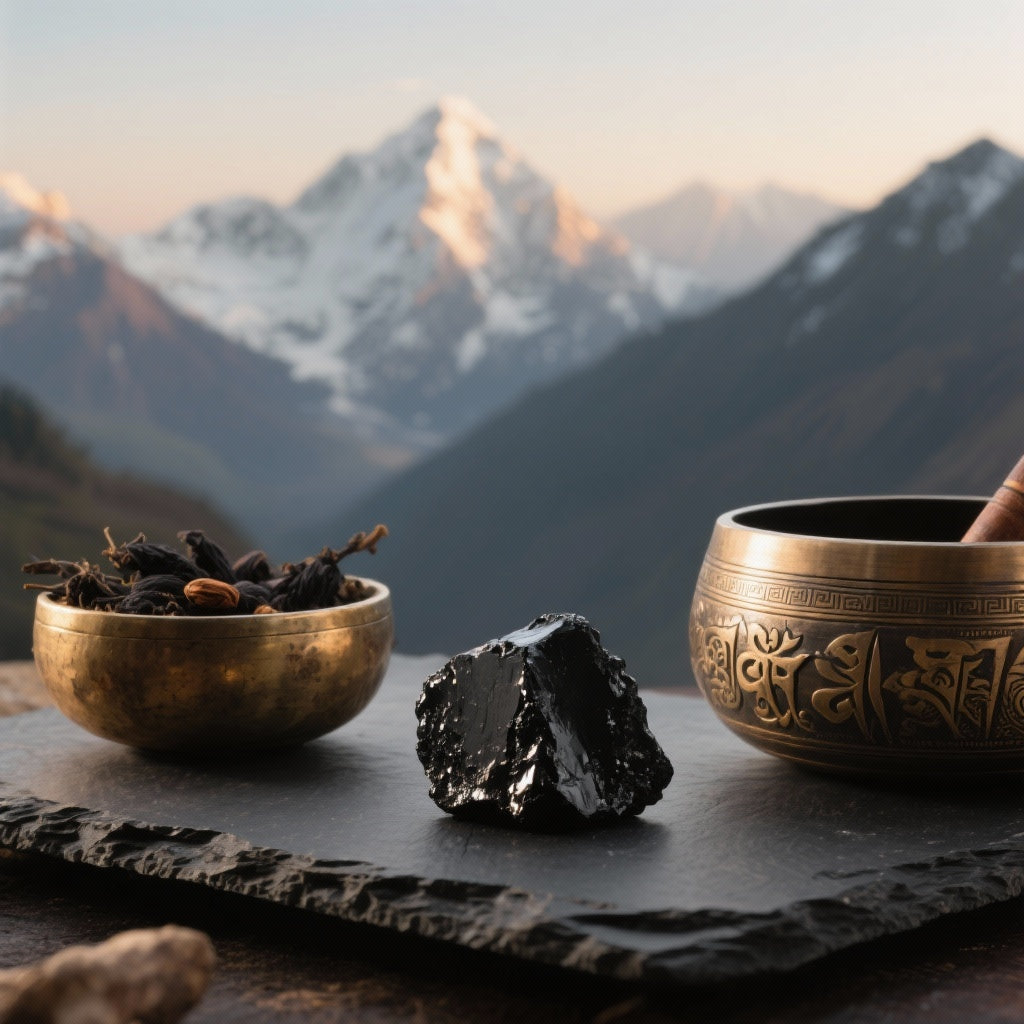Tibetan Medicine vs. Ayurveda: Deciphering Two Ancient Wisdoms on Shilajit
Deep within the majestic peaks of the Himalayas lies a natural treasure, an enigmatic substance revered for millennia: Shilajit. Known as the "conqueror of the mountains" or the "sweat of the rocks," this gift of nature is a cornerstone of two of the world's oldest medical traditions: Indian Ayurveda and Tibetan Medicine, or Sowa-Rigpa. While they share a common reverence for this potent remedy, their approaches, philosophies, and applications differ in subtle yet significant ways. You may be wondering which perspective resonates most with your needs? This comprehensive guide explores both, offering a clear understanding to navigate this ancient wisdom.
What is Shilajit? A Shared Treasure of the Himalayas
Before delving into the specifics, let's lay the groundwork. Shilajit, known as Brag-shun in Tibetan, is neither a herb nor a mineral in the strict sense. It is an organo-mineral resin, rich in fulvic acid and over 85 other minerals and trace elements. It forms over thousands of years through the slow decomposition of plant and microbial matter trapped in the rocks of high mountains. Both traditions recognize its unique origin and exceptional potency, considering it an adaptogen capable of restoring the body's vital balance. To learn more about its fundamental properties , our main blog is an excellent resource.
The Ayurvedic Approach: Shilajit as the Supreme "Rasayana"
Ayurveda, the Indian "science of life," is a holistic system focused on balancing the body's three fundamental energies, or Doshas : Vata (air/ether), Pitta (fire/water), and Kapha (earth/water). Illness is seen as an imbalance of these Doshas.
The Role of Shilajit in the Balance of the Doshas
In Ayurvedic medicine, Shilajit is classified as a Rasayana , a regenerator. It is one of the few remedies considered Tridoshic , meaning it can balance all three doshas simultaneously. Its taste ( rasa ) is primarily bitter, pungent, and astringent, and its energy ( virya ) is heating. This makes it particularly effective in pacifying excesses of Kapha and Vata. However, its potency is such that, when used correctly, it can even regulate fiery Pitta.
"There is hardly any curable disease that cannot be controlled or cured with the help of Shilajit."
Purification (Shodhana) and Use
Ayurveda places crucial emphasis on the purification of raw Shilajit, a process called Shodhana . Raw Shilajit can contain impurities or heavy metals. The traditional process often involves dissolving the resin in a decoction of herbs, such as Triphala, then filtering and sun-drying it to obtain a pure and bioavailable substance. It is often recommended to consume it with warm milk, ghee, or honey to enhance its absorption and effectiveness.
Tibetan Medicine (Sowa-Rigpa) and the "Brag-shun"
Tibetan Medicine, or Sowa-Rigpa ("science of healing"), is a complex system that integrates elements of Ayurveda, Chinese medicine, and Himalayan shamanic traditions. It is based on the balance of three humors ( Nyes pa ): rLung (wind, similar to Vata), mKhris-pa (bile, similar to Pitta), and Bad-kan (phlegm, similar to Kapha).
Brag-shun: The Conqueror of "Cold" Diseases
In Tibetan medicine, Brag-shun (Shilajit) is considered "the jewel of all medicines." Its main strength lies in its ability to treat complex and chronic illnesses, particularly those related to Bad-kan and rLung , which are disorders of a "cold" nature. It is renowned for its ability to "warm" the body, strengthen the digestive system (the "digestive fire" or medrod ), and nourish the bone marrow. It is often the main ingredient in complex formulas designed to treat kidney, liver, and digestive ailments.
A Holistic Approach: Body, Mind and Astrology
One of the major distinctions of Sowa-Rigpa is its integration of mind and environmental factors. Diagnosis is not limited to physical symptoms but includes pulse analysis, urine analysis, and even astrological influence. Brag-shun is used not only to heal the physical body but also to calm the mind and strengthen spiritual connection, a fundamental aspect of a balanced lifestyle .
Comparative Table: Ayurveda vs. Tibetan Medicine
| Criteria | Ayurveda (India) | Tibetan Medicine (Sowa-Rigpa) |
|---|---|---|
| Name of the substance | Shilajit (शिलाजित) | Brag-shun (བྲག་ཞུན་) |
| Fundamental Principle | Balance of the 3 Doshas (Vata, Pitta, Kapha) | Balance of the 3 Humors (rLung, mKhris-pa, Bad-kan) |
| Classification | Rasayana (regenerator), Yogavahi (potentiator) | "A jewel among medications," it treats the root cause of chronic diseases. |
| Main Use | Rejuvenation, vitality, general balance (Tridoshic) | Treatment of "cold" illnesses, strengthening of digestive fire and kidneys |
| Philosophy | Focus on internal balance and lifestyle | A holistic approach encompassing the body, mind, spirituality, and environment. |
Key Convergences and Divergences
Despite their differences, the two systems converge on essential points. Both consider Shilajit a panacea, a powerful adaptogen capable of improving longevity and vitality. The necessity of its purification is a shared belief, ensuring its safety and efficacy. The main divergence lies in their philosophical scope: Ayurveda focuses intensely on internal physiological balance through the doshas, while Sowa-Rigpa adopts a broader perspective, integrating external, mental, and spiritual factors into its diagnosis and treatment. Tibetan medicine often uses Brag-shun as a central ingredient in complex formulas, whereas Ayurveda also frequently prescribes it alone or with simple potentiators.
FAQ: Your Questions about Shilajit
Is the Shilajit physically different in the two traditions?
No, the basic substance is the same. Shilajit and Brag-shun both come from the same regions of the Himalayas. The differences lie in the purification methods, the formulations (alone or with other herbs), and the philosophy of application that guides its use.
Should I consult an Ayurvedic or Tibetan practitioner?
The choice depends on your own philosophy of health. If you are drawn to a system focused on diet, lifestyle, and balancing the body's energies, Ayurveda might be right for you. If you are looking for an approach that fully integrates mental, spiritual, and environmental aspects, Tibetan Medicine might be more aligned with your needs. In any case, seek out a qualified practitioner.
Can Shilajit be integrated into a modern routine?
Absolutely. Shilajit is a powerful supplement for the modern world, helping to combat stress and fatigue. The key is to choose a high-quality, purified product. You can easily add it to your morning drinks. Discover creative ideas on our recipe blog .











